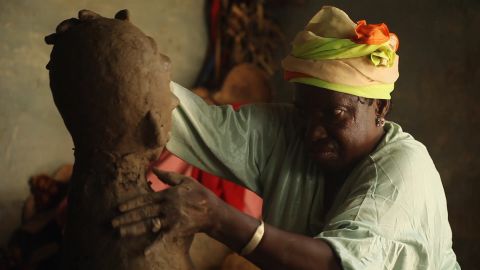Giving Birth
Screening followed by a conversation with Fatou Kandé Senghor & Wakanyi Hoffman
Screening, Conversation
Sat., 25.5.2024
19:00
Haunani-Kay Trask Hall
In English with German translation
Free entry

Still from Fatou Kandé Senghor, Giving Birth (2015).
Giving Birth is the story of ceramist Seni Awa Camara, a Senegalese artist from the Diola community, a people known for their animism and complex agricultural practices. Camara grew up in a ceramist home where people made pots and other vessels to eat and drink from. One day, amidst the ceramics, the family finds odd figurines that nobody recognizes and that are attributed to the girl. The girl and the figurines become a tiny family growing up in alterity, with gossip about magic and other powers accompanying her wherever she goes. After following her work for many years, director Fatou Kandé Senghor was invited to follow Camara, listen to her stories, sometimes with and sometimes without a technical team, the result of which is the film Senghor has named ‘giving birth’ after its completion. The film merges notions of motherhood and giving life to artistic practice and the mystical figurines that seem to come from elsewhere, from an otherwise world, but may very well be the girl's own attempt at reconfiguring patriarchal family structures. As an artist, Camara’s only family potentially remains self-fashioned, made from clay and contained in a secret world that only the artist has access to. The film tells a story about alienation, about the power and potential of reproduction, and the technologies at play in struggles against layered forms of patriarchal power.
After the screening, the filmmaker Fatou Kandé Senghor joins a conversation with African Indigenous knowledge scholar Wakanyi Hoffmann. The conversation discusses non-biological reproduction and notions of giving birth, technologies that multiply and reduce the stories we can tell about ourselves, and the role that AI might play in a variety of cosmologies and stories of bodies and families.